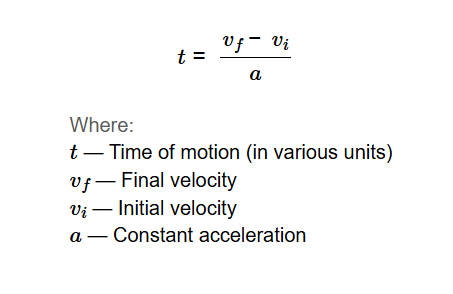 Home
Home
 Back
Back

Definition: This calculator computes the time of motion (\( t \)) of an object under constant acceleration based on its initial velocity (\( v_i \)), final velocity (\( v_f \)), and acceleration (\( a \)).
Purpose: It is used in physics to determine the time taken for an object to change its velocity under constant acceleration, applicable in motion analysis, vehicle dynamics, and projectile motion.
The calculator uses the relationship:
Where:
Explanation: Enter the initial velocity, final velocity, and acceleration in the chosen units, and the calculator computes the time of motion. Results are displayed with 5 decimal places, using scientific notation if the value exceeds 100,000 or is less than 0.0001. For default inputs (\( v_i = 0 \, \text{m/s} \), \( v_f = 10 \, \text{m/s} \), \( a = 2 \, \text{m/s}^2 \)), the calculated time \( t \) is 5.00000 s.
Details: Calculating the time of motion is essential for analyzing the duration of motion under constant acceleration, aiding in the design of vehicles, simulations, and motion control systems.
How do I find the time of motion?
Measure the initial velocity, final velocity, and acceleration in meters/second and meters/second², respectively. Compute the time using the formula \( t = \frac{v_f - v_i}{a} \). The result will be in seconds.
What does time of motion represent?
Time of motion represents the duration it takes for an object to change from its initial velocity to its final velocity under constant acceleration.
What is the formula for time of motion?
The formula for time of motion is \( t = \frac{v_f - v_i}{a} \), where \( v_f \) is the final velocity, \( v_i \) is the initial velocity, and \( a \) is the acceleration. The standard unit for time is seconds (s).